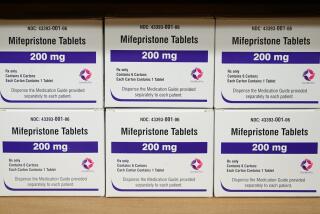Doctors can change opioid prescribing habits, but progress comes in small doses

When they started practicing medicine, most surgeons say, there was little or no information about just how many pain pills patients needed after specific procedures.
As a result, patients often went home with excessive amounts of powerful and addictive medications. Then the opioid crisis hit, along with studies showing one possible side effect of surgery is long-term dependence on pain pills. Some medical centers and groups of physicians responded by establishing surgery-specific guidelines.
But questions remained: Would anyone pay attention to the guidelines? And would smaller amounts be sufficient to control patients’ pain?
The answer to both questions appears to be yes — in some measure — according to a study that encompassed nearly 12,000 patients in 43 hospitals across Michigan. Details of the study were published this week in the New England Journal of Medicine.
Seven months after specific guidelines for certain operations were issued in October 2017, surgeons reduced the number of pills they prescribed patients by nearly one-third, with no reported drop in patient satisfaction or increase in reported pain, according to the research.
“We’re not trying to deny patients narcotics,” said Dr. Joceline Vu, one of the paper’s authors and a general surgery resident at the University of Michigan. “But there’s an acceptable level where people are still happy and still have their pain under control, but we have dropped the number to a minimum.”
Overall, doctors prescribed eight fewer pills per patient — dropping from 26 to 18 — across nine common surgical procedures, including hernia repair, appendectomy and hysterectomy.
Patients also reported taking fewer pills, dropping from 12 to nine on average across those procedures — possibly because they were prescribed fewer in the first place.
Still, while researchers say the study offers considerable reason for encouragement, it illustrates how hard it is to change prescribing habits. At the end of the study period in May 2018, the average number of pills prescribed exceeded the most up-to-date recommendations for all nine procedures.
And that’s in a place where there has been a concerted push to change prescribing habits through the Michigan Opioid Prescribing Engagement Network (Michigan OPEN), a collaboration of hospitals, doctors and insurers. Most states haven’t made such an effort.
“There is a misconception that this is all fixed,” said Dr. Chad Brummett, co-director of Michigan OPEN and one of the researchers involved in the study. “I do think people are still overprescribing. Definitely.”
The results come amid ongoing concern about the opioid crisis and a continued examination of the role prescription drugs played in its escalation.
The likelihood of persistent opioid use rises with the number of pills and the length of time opioids are taken during recuperation from surgery.
But there’s another avenue of concern: When doctors prescribe a generous number of pills, the chance of leftovers increases, along with the potential for unused pills to make their way from medicine cabinets to the street, or to fall into the hands of other family members.
“That can be a bigger concern for many of us,” Vu said. “It seems that in surgery, for whatever reason, we wrote prescriptions for a lot more opioids than people actually needed.”
The Michigan OPEN guidelines recommended amounts based on how much pain medication patients actually took following surgery.
Other institutions have developed their own surgery-specific prescribing principles, including Johns Hopkins Medicine in Baltimore and the Mayo Clinic in Minnesota. Although they use different methods to determine the optimal number of pills, most ended up with similar parameters, often in the range of zero to 20 pills, depending on the procedure.
All the prescribing directives apply to patients with acute pain, such as those who had surgery, and not people with chronic pain, Vu and other researchers emphasized. Even so, patients struggling with chronic pain argue that such guidelines have made it far more difficult for them to get treatment.
“These patients feel besieged … and say, ‘I need these pills to get out of bed in the morning,’” Vu said. “This project and study is not about chronic pain. It’s about preventing harm to healthy people coming in for surgery.”
What are some of the guidelines? In its initial recommendation, Michigan called for no more than 10 pills equivalent to 5 milligrams of oxycodone for a minor hernia repair, and no more than 20 for a minimally invasive hysterectomy.
The resulting changes offer important context.
Before the guidelines, for instance, patients with minor hernia repair operations were being prescribed 29 pills, according to the study. That fell to 14 by May 2018, which is still four more pills than the guidelines suggest.
For a hysterectomy, though, patients received 31 pills before the guidelines and 19 after, just below the “no more than 20” recommended. Michigan OPEN later revised its recommendations, further lowering the range amounts to zero to 10 for hernia repair and zero to 15 for a hysterectomy.
In sheer numbers, opioid prescribing rates in the U.S. peaked in 2010, but remain among the highest in the world, according to studies and other data. The postsurgical prescribing falloff seen in Michigan does not likely reflect a broader trend, especially where there is less emphasis on such guidelines.
Appleby and Lucas write for Kaiser Health News, a nonprofit news service covering health issues. It is an editorially independent program of the Kaiser Family Foundation, which is not affiliated with Kaiser Permanente.






